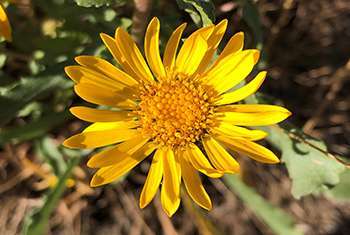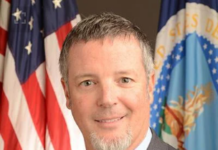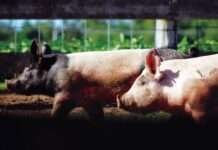Curlycup gumweed is a native forb that competes well against invasive weeds in disturbed soils while providing an excellent food source for pollinators. Reclamation and restoration plantings are usually developed with the goal of establishing a stable plant community. To determine what species may perform well in an area, land managers can refer to nearby reference sites or an Ecological Site Description. However, many restoration sites may not have the capability to support the species present in an undisturbed reference area. Plant species return to disturbed sites in stages; beginning with plants that establish the site, build soil health and serve as nurse plants for longer lived species. Often, these early establishing plants are referred to as weeds or disturbance loving species.
NRCS Plant Materials Centers (PMCs) are investigating disturbance loving native plant species to develop new conservation plant releases for site establishment. The Aberdeen PMC in Idaho, for example, is currently evaluating curlycup gumweed, a common native forb found along roadsides and disturbed sites throughout the west. As its name indicates, it is commonly considered to be a weed. Despite its weedy designation, PMC studies show it has many beneficial characteristics for restoration such as providing pollinator habitat, wildlife food and cover (sage grouse) and potential as a natural fire retardant in vegetative fuel breaks. One or more Selected Class releases of curlycup gumweed are scheduled to be released to the native seed industry for use in seed mixes.
Dilley Germplasm slender grama in a restoration planting. The Kika de la Garza PMC in Kingsville, Texas, has released several germplasms that fit into the disturbance loving category. Neuces Germplasm sand dropseed, Dilley Germplasm slender grama, and Welder Germplasm shortspike windmillgrass were all developed for their ability to reclaim disturbed areas and provide immediate cover while allowing longer-lived species to establish.
The James E. “Bud” Smith Plant Materials Center in Knox City, Texas, recently released Menard Germplasm purple threeawn, a warm season perennial bunchgrass found across western North America, extending from Canada into Mexico. Purple threeawn can be used for critical area site revegetation, erosion control, and right-of-way plantings due to its fibrous root system and ability to establish and persistence in low moisture environments. This species can also be included in range and wildlife seeding mixes to increase species diversity.
It is important to keep in mind the natural succession of disturbed areas when developing seed mixes. The Plant Conservation Alliance has recently developed a National Seed Strategy offsite link image . Part of this strategy is to use “The right seed, in the right place, at the right time.”. Conservation practitioners should always strive to use the right plant to meet resource objectives whether that is forage production, disturbed site reclamation or native habitat restoration. The right choice could be a short-lived native that has evolved to capture disturbed sites and pave the way for longer lived perennial species. Sometimes a weed is not a weed. Sometimes a weed is the best tool for the job.
For additional information on specific species of plants mentioned, please see the USDA PLANTS database. Technical information and guidance on the use of conservation plants to address resource concerns can be found on the Plant Materials Program website or contact the nearest Plant Materials Center or plant materials specialist.





